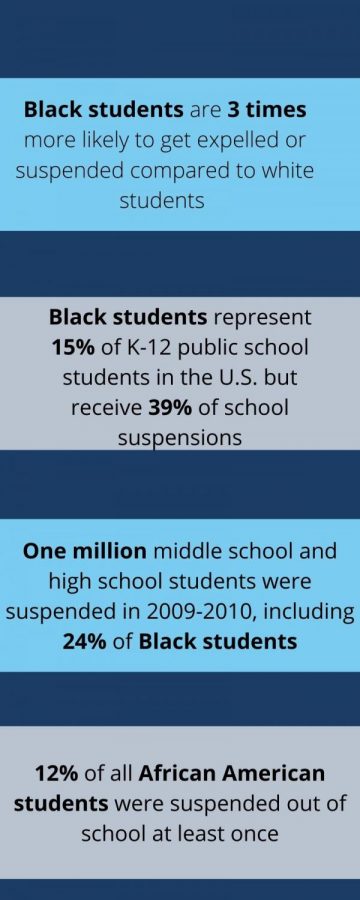Black students face harsh disciplinary punishments across the U.S.
January 5, 2021
Four 12-year-old African American girls were strip searched for drugs in Binghamton Middle School on Jan. 25, 2019, after being perceived as “hyper and giddy.” According to Illinois Legal Aid Online, strip searching students in schools to check for weapons or any illegal substances is only allowed if they pose a threat to the school. Binghamton Middle School had used racial prejudice as an excuse to strip search students.
“No one should be strip searched just because of the way they are acting,” senior Alexandra Reaves said. “When people do something wrong, we think that the school staff should face consequences, but the people superior to them[the district administration] may have done the same thing, so they do not reprimand them for their actions.”
Due to racial bias, students of color suffer harsher discipline for lesser offenses compared to their white peers. According to Forbes, the disciplinary action taken against Black students, in the U.S., is more frequent than white students in counties with more racial bias, where people of color are viewed as more likely to do something wrong based on society’s labels.
“[Many] people who are not [Black] see Black people negatively and as criminals,” Reaves said. “A lot of it has to do with the media and how we are portrayed. We are getting punished more heavily than others because we are expected to be doing something wrong.”
According to futurity, in elementary schools Black students are facing disparities based on racial discrimination because of the categories the teachers used as a reason for punishment such as ‘defiance’ and ‘disrespect’. These reasons aren’t detailed and so teachers use this as an easy way to accuse and read the behavior of a student, even when their actions were not even intended that way.
“Some teachers label black students based on the way they act, dress, what they are known for in society,” junior Ailyah Wilkes said, “So these punishments tag along because of these stereotypes of black students.”
Black students face a higher degree of punishment compared to white students due to historical actions. According to Time, the white supremacist society took advantage of their power over Black people, due to slavery, and created the racial stereotype that they were untrustworthy and dangerous. So even after their human rights were returned, Black people were still labeled and heavily discriminated against, which continues to affect the Black community.
“When Black voices aren’t heard, that’s when a lot of injustices occur because there aren’t people speaking up for the community,” senior Alex Nesmith said. “[Other people] don’t know what it’s like to be in that situation, so they are not going to understand how bad it is.”
According to ThoughtCo, the racial prejudice Black students face in America, has contributed to higher suspension rates and excessive absences, which can prevent some Black students from receiving an education of the same quality as their white peers. These factors produce a substantial gap in academic achievement between Black and white students.
“We have to be a better nation and live by what we say we stand by,” Wilkes said. “We need to kill that selfishness in our society and spread more equity and respect.”



